Use 'Print preview' to check the number of pages and printer settings.
Print functionality varies between browsers.
Printable page generated Wednesday, 19 November 2025, 11:27 PM
Health Education, Advocacy and Community Mobilisation Module: 2. Approaches to Health Education
Study Session 2 Approaches to Health Education
Introduction
In the first study session you learned ways in which you can think about the concept of health and discovered some of the overall principles of health education. In this study session you will learn about the targets of health education, its goals and approaches as well as its application in your day to day community health education sessions. You will also learn to understand your wider role as a health educator within your community setting.
Health education and health promotion builds on a social and cultural understanding of health and illness within your community. The approach to health education used in this study session aims to improve access to health-related information, knowledge and services that will give people more control over their own health and wellbeing.

The knowledge referred to in this study session deals not only with the dissemination of simple health facts, but also with more detailed health messages. These messages include specific information and skills, such as negotiation and coping strategies, which can help prevent illness and promote health. It is important to use more detailed messages and promote specific skills in your work because this will help you to positively influence peoples’ behaviour and bring about desired healthy behaviour and practices.
Learning Outcomes for Study Session 2
When you have studied this session, you should be able to:
2.1 Define and use all of the key words marked in bold. (SAQs 2.2, 2.3 and 2.4)
2.2 Determine the overall targets of your health education activities. (SAQ 2.1)
2.3 Discuss the ultimate goals of health education to help you achieve your health education objectives. (SAQ 2.2)
2.4 Describe the basic approaches of health education that you should consider for your health education sessions. (SAQ 2.3)
2.5 Discuss the scope of health education and the role of Health Extension Practitioners while implementing health education. (SAQ 2.4)
2.1 Targets of health education
As a Health Extension Practitioner you will use health education activities to promote healthy behaviour and practices in the community you work in. Each individual and every community needs to think about what will bring them a healthy life. There are different risk factors in each locality that expose people to unhealthy conditions and lead to sickness and disease. Health education activities are expected to reduce these risk factors and maintain the health of your community.
Every stage of life, each and every individual or social group in your community and all occupations are appropriate targets of health education programmes. The following sections cover the main target groups for health education programmes. It is important for you to adapt your health education methods and activities to fit the group or audience you are targeting.
2.1.1 Individuals
All Health Extension Practitioners are expected to use health education to communicate with individuals within their community. Individuals include all health service users such as women receiving antenatal care, school children, adolescents and young children. You will be able to deliver health education messages at both household and at a community level.
For example, it is likely there will be TB patients in your community who are receiving anti-TB drugs. Health education for these individuals will include giving advice to cover their mouth while coughing, adhere to the full course of their treatment as well as a variety of other educational issues that will help them get better themselves — and protect the rest of the community from infection.
2.1.2 Groups
Groups are gatherings of two or more people with a common interest; they are a good target for your health education sessions (Figure 2.2). To understand the concept of group health education, imagine that there is a gathering of an HIV/AIDS peer educator group at the local secondary school. You may well be invited by the school administrator to deliver health messages on HIV/AIDS to help train groups such as these.
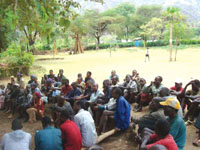
Look at the list below. What type of health education activity is each of these? Are they individual or group? When you have done this spend a few minutes thinking about the balance between group work and individual work that a Health Extension Practitioner should try to achieve. Which aspects of group work or individual work do you think you will enjoy most?
- a.A family planning service for a couple
- b.A school club about HIV/AIDS
- c.A gathering of mothers about breast feeding their children
- d.Class students learning about hygiene and sanitation
- e.Factory workers understanding about occupational health hazards
- f.Counselling of a pregnant mother about issues relating to her pregnancy.
Except for activity (f) which is individual in all the above are examples of group health education activities. As a Health Extension Practitioner you may well become involved in all of these or similar activities. Notice too though that all of these activities (a) to (e) might at some point be done with individuals. There is no fixed rule about what is a group activity and what is individual activity.
2.1.3 Community
Health education is among the tasks that all Health Extension Practitioners will also be expected to implement at community level. A community can be described as a collection of people who have a feeling of belonging and share a common culture, beliefs, values and norms. In this context a community will also have a common interest regarding the possible health problems within your area.
Your community is a specific group of people, often living in a defined geographical area and arranged in a social structure according to relationships that the community has developed over a period of time. Members of a community gain their personal and social identity through shared culture, beliefs, values and norms. All health education work relies on good relationships with people in your community (Figure 2.3). Community members will also exhibit some awareness of their identity as a group, their common needs and will have a commitment to meeting these needs.
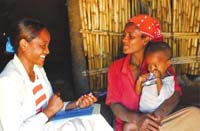
A community could be a town or a large area that is sparsely populated, it might also be the people involved with the school where you are working or a work site.
Imagine that you are a Health Extension Practitioner who has been invited by your kebele administrator to deliver health messages on malaria prevention to a gathering in your village. What type of health education is this and who do you think your target audience for this message would be?
Malaria is a health issue that affects many different people in the village. A message about its prevention is part of community-level health education so your target audience will be the whole community.
2.2 Educational objectives of health education
In this section you will learn about the objectives of your health education activities. One of the most important objectives is to provide appropriate knowledge.
Knowledge is the collection and storage of information and experience. Good quality health education relies on the provision of correct, credible, simple and understandable facts and information. Providing knowledge is about helping someone who has a problem, in the case of your job a health problem, so you will have to be aware of the possible health problems, their consequences and ways of preventing them.
Box 2.1 TB health education messages
- People with persistent coughing should visit the nearby health centre for sputum tests because a cough lasting two weeks or more is a symptom that could be a sign of TB.
- Those people confirmed as TB patients and put on anti-TB drugs should adhere to their medication to prevent possible drug resistance and to help cure their disease.
Look at the messages about TB in Box 2.1. Which message do you think is the most important?
The truth is that both messages are very important, but they will be useful to people at different stages of their disease. As a Health Extension Practitioner you will have to understand which is appropriate knowledge to pass on to the people in your community and when to deliver the knowledge.
Another important objective of health education is to help people to develop a positive attitude. Attitude has a lot to do with changing people’s opinions, feelings and beliefs. Health education aims to encourage an attitude that helps people maintain healthy practices and behaviours. A positive attitude can also help with decision-making so that they are able to choose healthy practices for themselves and their families.
Health education can have a huge impact on people’s attitudes towards healthy behaviour and practices, as Case Study 2.1 illustrates.
Case Study 2.1 Genet
When working as a Health Extension Practitioner, Genet found that the community she was working in commonly practised female genital mutilation (FGM). Genet wanted to change the community’s attitude towards practising FGM and would regularly carry out health education activities with different individuals and groups within the community. For example, she organised a group meeting for the women living in the community and gave an audiovisual presentation on the health risks associated with FGM. Genet followed this with a discussion where the women could talk about the practice and ask questions about her presentation. She put up posters like the one in Figure 2.4. The belief that FGM is a harmful traditional practice became the most commonly held view amongst community members.

Consider an attitude related to a health issue that you think has recently changed in a community you know about. Think for a moment about the way that health education activities may have influenced that change.
It is worth remembering and jotting down sequences of health education activities that help to bring about attitude change. It is all evidence for you to build on of what works, who listens and how to develop your activities.
2.2.1 Decision-making
Decision-making based on awareness or knowledge about a health issue is about people’s ability to choose healthy behaviours and practices from a range of alternatives. To do this people need to understand their health needs and the different options available for meeting them. Health education is a very important way that people in your community can develop decision-making skills for themselves.
Read Case Study 2.2 below, and after you have done so, think about an occasion when health education messages have helped to change the attitude of someone you know.
Case Study 2.2 Abebe
Abebe is 18 years old and attends high school. Due to influence from his friend Tadese, he smokes cigarettes. You frequently go to his home and tell him that he is damaging his lungs due to smoking and he is at risk of lung cancer, and that his girlfriend will probably think it is dirty. At first he refused to listen to you, however one day he told you that he believes that smoking is harming his health. After a few days he completely stopped smoking cigarettes.
Why do you think Abebe stopped smoking?
Abebe changed his attitude and now he believes that smoking is harmful because he was given enough knowledge and information to help him in his decision-making. For example, smoking causes cancer and heart disease he also probably changed his mind because of the effect it might be having on his girlfriend.
2.3 Goals of health education
For a Health Extension Practitioner the main goal of health education is to enable each individual and family within your community to exercise their right to develop and achieve their physical, mental and social potential.
Through health education you should aim to help prevent illness and disease, maintain and improve the health of your community members, reduce exposure to risk factors and help people adjust so they are more able to live with disabilities.
Look at the paragraph above again and think about health education messages that have been focused on:
- Prevention
- Maintenance and improvement of health
- Reduced exposure to risk
- Adjustment to disability.
It’s clear that these aims are all linked. For example, reducing risk can improve health and prevent disease, and adjusting to disability can prevent mental health problems and reduce self-harming behaviours. Your health education messages can be anything from very straightforward to very subtle messages which affect whole lives.
Understanding health education approaches will help you to influence your community and encourage the desired healthy behaviour and practices.
Persuasion is often used by Health Extension Practitioners to influence the behaviour of their community. Imagine you have analysed the latrine usage within your area and found that many people are not using the latrines that have been constructed. You could try to persuade the community to increase latrine usage by explaining the health risks of not using a latrine and stressing the benefits of using one. After using the persuasion approach you should follow up by making frequent visits to the households you surveyed and checking that they are still using the latrines.
2.3.1 Informed decision-making
Informed decision-making focuses on providing the necessary health information needed to create awareness of a health problem in your community. This approach leaves the actual decision-making about action to the individuals. You might use several different methods in this approach including giving people information about the issues and teaching decision-making skills. It is important to allow people in the community to make the choice themselves as this will build their decision-making skills.
For example, imagine that you have gathered cigarette smokers in your community together. You conduct a health education session aimed at creating awareness about the health risks of smoking cigarettes. During the session you include a role play activity where different members of the group take it in turns to play a smoker and a doctor discussing the health risks associated with smoking. This type of activity encourages decision-making and will help people to make their own decision about whether to stop smoking.
2.4 Approaches in health promotion
Health promotion will be an important part of your work as a Health Extension Practitioner. In this section you will now learn about some of the key approaches used in health promotion.
2.4.1 Behaviour change
The behaviour change approach is used to bring about changes in an individual’s thinking or perception. You should be able to use this method to change the behaviour of individuals within your community and help them make their own health-related decisions. This approach can be applied using locally available methods and media such as leaflets and posters.
The behaviour change approach is very broad; you will be expected to consider wider issues of health education such as individual perceptions of exposure to health risks and risky behaviour. This approach also covers the benefits an individual can gain through health practices.
Think about smoking for a moment. You’ll be aware that smokers deciding whether or not to give up smoking should consider:
- To what extent they think they are susceptible to high blood pressure (hypertension), lung cancer, social and financial consequences, and other smoking-related health problems
- Their perception of how serious continuing to smoke may be in terms of their possible future morbidity (illness) and mortality
- Their perception of the extent and value of the benefits of giving up smoking
- The potential negative consequences of giving up smoking.
Hiwot is a Health Extension Practitioner. She wants to help young adolescents who are exposed to smoking in her area. How do you think she could use the behaviour change approach to health promotion outlined above to do this? What ways do you think Hiwot might use to help the young adolescents to decide whether to give up smoking or not?
Hiwot could invite adolescents and young men who smoke to a group meeting (Figure 2.5), where several things can happen.
- She could hold an activity such as an audiovisual presentation about the health risks associated with smoking. This would help the young adolescents to consider all these factors and then decide for themselves whether to stop smoking.
- She could also use a discussion group after the presentation to help them explore the social aspects of smoking, why people do it and what good things they can find in giving up both now and in the future. Importantly she could also give hints and tips for actually giving up.
- Hiwot does not smoke herself so she is also acting as a role model for the young adolescents.
- So she uses a number of behaviour change methods: giving information, opinion-forming, and modeling healthy behaviour.
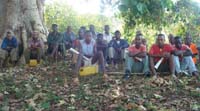
2.4.2 Self-empowerment
Your role as a Health Extension Practitioner will be to help individuals in your community make healthy choices. It’s important to remember that self-empowerment is rooted in awareness and understanding that people can act to change their own lives on their own behalf (Figure 2.6). Using the self-empowerment approach you can provide the tools they will need to make their own choices about their health and increase their control over their physical, social and psychological environment. Self-empowerment techniques include, but are not limited to, group work, problem solving, client-centered counselling, assertiveness training, social skills training and educational drama. You will learn more about these techniques in future study sessions.
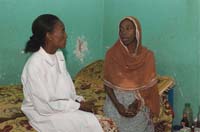
Suppose that you as Health Extension Practitioner planned to create awareness amongst your community members on the problems of tuberculosis. Write down some of the ways you can create awareness about tuberculosis and so help people to begin to act positively for themselves.
You may have thought of some of the following ways:
- Health education sessions are important for the community to reduce transmission of tuberculosis by helping people to understand how to break the route of transmission.
- A health education session would help you to identify those people with signs and symptoms of tuberculosis and encourage them to take action and visit a larger health facility for diagnosis.
- Your health education session could encourage patients who are already on anti-TB medication to adhere to their treatment, which is a form of personal action which will help prevent drug-resistant TB.
2.5 Community development
This approach requires the participation of community members at every stage of the programme. Community development is a collective action where members of the community participate in assessing the needs of the community and help in the planning of actions, targets and goals to meet those needs. This approach includes the interpersonal skills component of the self-empowerment approach.
At the community level there are many influences over health-related behaviours, some of these such as social and cultural norms, beliefs, and values have been covered in this Module, but influences can also include factors such as the local socio-economic situation of your community and prevailing environmental conditions such as drought or floods.
Community participation is essential for you as a Health Extension Practitioner to understand and deal with those influences. Communities often have detailed knowledge about their history, culture and surrounding environment so it is crucial to include them at all stages of your community development activities. If the community is involved in choosing healthcare priorities and making plans those people are much more likely to become involved in the implementation of your health education activities, and these are more likely to be successful.
Encouraging participation is also important for developing the self-reliance, empowerment and problem-solving skills of your community members, it will also enable you to use locally available resources and help you to create better relationships with the people in the community you are working in.
Spend a few moments thinking about community involvement in a health issue that you are aware of. Who have the active participants been? What was the health issue? What sorts of activities, meetings and information sharing took place? Do you feel that people in the community really felt that they were participating? Do you think anyone resisted the ideas and activities that were going on?
In issues like community participation the more you think about what went on, what worked well, what could be improved as well as who needs ‘winning over’ next time, the more evidence you are building up for future work.
2.6 Health Extension Practitioners and health education
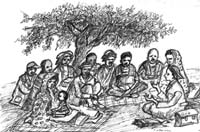
The Health Extension Programme is an innovative community-based programme. As a Health Extension Practitioner you will be expected to help address the health problems of your community. All your efforts on health promotion and disease prevention activities should include the full participation and involvement of your community members (Figure 2.7). Health education is an important tool that helps you to implement all community-based packages of the Health Extension Programme.
The Health Extension Programme focuses mainly on prevention and community-based health promotion activities. Preventive activities are usually considered in the levels:
- Primary prevention includes those measures that prevent the onset of illness before the disease process begins. Immunization against infectious disease is a good example.
- Secondary prevention includes those measures that lead to early diagnosis and prompt treatment of a disease. Breast self-examination is a good example of secondary prevention.
- Tertiary prevention involves the rehabilitation of people who have already been affected by a disease, or activities to prevent an established disease from becoming worse. These activities are less likely to be undertaken by Health Extension Practitioners.
At the primary prevention level your health education activities will focus on changing behaviour by raising awareness of the risk factors that predispose your community members to future health problems. For example, imagine that you distribute insecticide treated bed nets (ITN) to prevent the pregnant mothers in your area getting infected with malaria. This is primary prevention because you are preventing exposure to malaria. Your role as Health Extension Practitioner is to use health education to create awareness among the pregnant women on how and why to use ITN. Health education also includes secondary prevention methods such as early diagnosis and treatment and extends to tertiary prevention such as rehabilitation.
Before finishing this session, think about a health education issue that you are familiar within your community or area. Make a note of a primary prevention action and a secondary action that has been taken.
Make sure that you are comfortable with the difference between primary prevention activities and secondary prevention activities. Remember that primary prevention activities will actually stop the illness happening, while secondary activities stop the illnesses getting worse.
Summary of Study Session 2
In Study Session 2, you have learned that:
- Individuals, groups and communities are all targets for your health education sessions and it is important to adapt your work for each type of audience.
- The objectives of health education include providing knowledge, developing positive attitudes towards health issues and promoting decision-making.
- The ultimate goal of health education is to promote, maintain and improve individuals’ and community health. Health education is aimed at reducing morbidity and mortality due to preventable health problems.
- Persuasion and informed decision-making are important types of health education approaches.
- The scope of health education at community level includes raising awareness about primary prevention. Health education includes secondary prevention methods such as early diagnosis and treatment and extends to tertiary prevention such as rehabilitation.
Self-Assessment Questions (SAQs) for Study Session 2
Now that you have completed this study session, you can assess how well you have achieved its Learning Outcomes by answering these questions. Write your answers in your Study Diary and discuss them with your Tutor at the next Study Support Meeting. You can check your answers with the Notes on the Self-Assessment Questions at the end of this Module.
SAQ 2.1 (tests Learning Outcome 2.2)
Suppose that you want to conduct health education sessions on exclusive breastfeeding, in order to prevent health and nutritional problems of newborn babies. Who is the target for your health education sessions?
Answer
Pregnant and recently delivered women could be mentioned as a target for your health education sessions. Of course the fathers and other family members should not be forgotten because they will be important people who will be able to reinforce the messages to the breastfeeding mothers.
SAQ 2.2 (tests Learning Outcomes 2.1 and 2.3)
Imagine that you carried out an assessment of latrine usage in your community and found it to be very low. You plan to conduct health education sessions with your community on the importance of using latrines. What would be your overall goal? In the sessions what do you think your educational objectives would be? What framework would you be working within?
Answer
Your overall goal would be to reduce morbidity and mortality due to low latrine usage.
Your educational objective should be providing appropriate knowledge, developing positive attitudes and helping your participants make an informed decision on latrine utilisation. So that means you would be working within a framework of informed decision-making.
SAQ 2.3 (tests Learning Outcomes 2.1 and 2.4)
You would like to conduct health education on antiretroviral treatment (ART) adherence among people living with HIV within your community. Write down a possible health education approach you could use for your health education sessions and why you think this would be appropriate.
Answer
You would use a behaviour-change approach, bearing in mind that knowledge about anitretroviral drugs doesn’t always mean that people will adhere to a course of drug treatment. Using persuasion to help your audience adhere to the course of ART drug treatment is likely to be more successful. This is because they will not only know about the drugs but will then feel committed to adherence.
SAQ 2.4 (tests Learning Outcomes 2.1 and 2.5)
Why is awareness an important term in self-empowerment work?
Answer
Self-empowerment is about people being able to act on their own lives, on their own behalf. But to do this they need to be aware of their own strengths and what resources are available to them. For Health Extension Practitioners, helping people become aware of these health issues is one of the most important elements in beginning self-empowerment work.